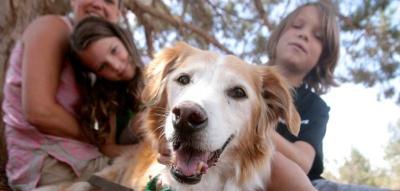
How to Prevent a Dog From Biting Children
Dogs and kids can have amazing relationships if both are taught how to properly interact and respect each other. Proper training and management of both children and dogs can prevent tragedies, such as dog bites, from ever happening.
When a child is bitten, both the child and the dog pay a high price. Even if the child is not physically damaged, they still might be emotionally affected. The dog might end up homeless (and a poor adoption prospect) in a shelter or lose their life.
That’s why it’s crucial to be proactive with teaching good behaviors, so dogs and kids can be safe around one another. Here’s what your child, your dog, and you need to know about dog bite prevention.
Home starts with you
What does my child need to know to prevent dog bites?
Children should learn how to be gentle and respectful around dogs — from family pets to unknown dogs. Even young children can begin to learn these lessons.
- Teach children that they should never tease or throw things at a dog. Teach them to be especially gentle and calm around dogs they don’t know.
- Teach children the proper ways to pet a dog and tell them not to pet strange dogs without asking permission. Let them know that tugging on a dog’s ears or tail can be painful, and the dog might feel the need to bite. It is also important to teach your children not to hug dogs, especially dogs they don’t know. That type of “confinement” can be scary to a dog, and it brings the child’s face close to the dog’s face, which can make the dog uncomfortable.
- Tell your children not to run, jump, or scream around an unfamiliar dog, as you don't know what actions might cause fear or predatory behavior in that animal.
- Remind your children not to stare at a dog when interacting with them. Children are often the same size as dogs and might stare into a dog’s eyes without meaning to or without understanding that the dog might feel threatened.
- Tell your children not to wake up a sleeping dog. The dog might be startled and react defensively.
- Tell your children not to climb on any dog, even the family dog. It might be perfectly safe with your own dog, but children then might try this with another dog and get bitten.
- Tell your children not to take things out of a dog’s mouth and to leave an eating dog alone. Even if your own dog does not guard toys or food, another dog might. Therefore, it is safer to teach a child to leave all dogs alone during mealtime or while dogs are eating treats. In addition, when around a strange dog, your child should not take away the dog’s toys.
What does my dog need to know?
Your dog also should be safely socialized with children to build their confidence and help prevent the chance of biting.
- Expose your dog to children, ideally from when they’re a puppy if possible. Watch your dog as they play with children; stop the play if the child or the dog gets too rough.
- Handle all your dog’s body parts, so they are not sensitive to touch. If your dog objects to any part of their body being handled, go to an area of their body that they like to have touched. As you talk soothingly to your dog, begin moving over to the area they don’t like touched. Praise your dog if they don’t react, and repeat this process until the dog is fine with touch everywhere. Use treats in addition to praise if necessary.
What do I need to know about dog bite prevention?
You are ultimately responsible for keeping your dog safe around kids. Besides practicing dog training cues and building a relationship with your dog, there are some other dog bite prevention strategies to take.
- Have your whole family go to training classes with the dog. Everyone in your family should have some understanding of acceptable dog behavior.
- Don’t stare into a dog’s eyes, as this can be threatening.
- Watch your dog carefully around other people’s children. When your dog doesn’t know the children, you can’t be certain of how they'll react.
- Get your dog checked by a vet if their behavior suddenly changes (e.g., the dog becomes more irritable). Sudden behavior change can mean your dog is in pain and needs medical attention.
Finally, if you have a dog who is not OK around children, it is your responsibility to protect your dog from their tendencies. Never allow your dog to be in a situation where they might bite a child. If you teach both kids and dogs how to properly interact, they will enjoy a wonderful, safe, fun relationship.
